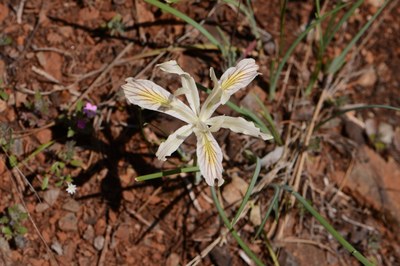
Trip
Day Hike - Grants Pass Area Siskiyous
Photo / naturalist-oriented hikes to spectacular spring wildflowers in premier NW serpentine areas, and enjoy bird sights and songs in Klamath-Siskiyous ecoregion aka "Galapagos of the Temperate World." See many unique, beautiful, rare and endemic wildflowers.
- Sat, Apr 20, 2019 — Mon, Apr 22, 2019
- Seattle Naturalists Committee
- Photography, Naturalist, Day Hiking
- Adults
- Easy
- Mileage: 4.0 mi
- Elevation Gain: 400 ft
- 5 (6 capacity)
- Cancellation & Refund Policy
2/25 update:
7:30am: Meet and depart Valley of Rogue State Park entrance (rest area)
8:30am: Meet at trailheads for hikes on Saturday - Limpy Creek; Sunday - parking area for Eight Dollar Mtn interpretive trail and Jeffrey Pine Loop, followed by TJ Howell Botanical Drive stops; Monday - Waters Creek
Directions to Limpy Creek (Saturday): From Grants Pass, drive southwest on Highway 199 to Riverbanks Road and proceed on Riverbanks Road to Limpy Creek Road. Follow Limpy Creek Road for approximately three miles to the trailhead.
Directions to Eight Dollar Mountain (Sunday): From Grants Pass, drive south on highway 199 for approximately 3 miles to the town of Selma, turn west (right) on the Illinois River Road (forest road 4201) for approx 1 mile where you will see a sign and a large paved parking area on the left for the Eight Dollar Mountain trail across the road, and the Jeffrey Pine Loop below the parking area. The TJ Howell drive begins on the Illinois River Road, west of Eight Dollar Mountain.
Directions to Waters Creek (Monday hike): From Grants Pass, drive south on Redwood Highway 199 for 14.4 miles, across the bridge above Applegate River, to Waters Creek Road (there are signs on the side of the road before the turn). Turn right and follow the road 2.5 miles to the trailhead.
4/10 update: See info below on Klamath-Siskiyous ecoregion, aka "The Galapagos of the Temperate World" where the Grants Pass botanical areas are located.
Members only
Day Hikes: Saturday - Limpy Creek; Sunday - Eight Dollar Mtn, Illinois River Vly trails, TJ Howell Botanical Drive stops; Monday AM - Waters Creek. See route/place details link for brief trail descriptions. Leader will provide copies of trail descriptions to participants.
* For those interested in bird and nature sound recording: these hikes access pleasant natural sound environments with little to no human/mechanical sound disturbances for long periods.
Consider adding 4/18-19 Mountaineers' Table Rocks trip to the Grants Pass area hikes to extend your naturalist/photo hiking explorations in SW Oregon. Also nearby are Oregon Caves National Monument, Crater Lake National Park, S Oregon coast, and serpentine botanical areas in northern California (near Smith River and Gasquet).
Links to Limpy Creek, Eight Dollar Mountain trail, TJ Howell Botanical Drive:
Limpy Creek: https://www.fs.fed.us/wildflowers/regions/Pacific_Northwest/LimpyBotanicalTrail/index.shtml
Eight Dollar Mtn: https://www.fs.fed.us/wildflowers/regions/Pacific_Northwest/EightDollar/index.shtml
TJ Howell Botanical Drive: https://www.fs.usda.gov/Internet/FSE_DOCUMENTS/stelprdb5313427.pdf
Serpentine plant communities info: https://www.fs.fed.us/wildflowers/beauty/serpentines/communities/index.shtml
Leisurely to moderate pace group hikes, with 20-minute lunch and opportunities for short to extended photo/naturalist stops. If you're looking for a faster paced hike or solo hiking, please consider joining a trip that better matches your expectations.
The Table Rocks and Grants Pass botanical areas are part of the Klamath-SiskiyousEcoregion, aka " The Galapagos of the Temperate World." More info below:
"Klamath-Siskiyous: The Galapagos of the Temperate World. If you adore plants, especially plant species that can only be found on lone mountaintops or remote river valleys, the Klamath-Siskiyou Ecoregion in southwest Oregon and northwest California is the place for you to explore! The region supports approximately 3500 species of plants, including 281 endemic plants that grow nowhere else in the world. Some particularly charismatic endemics, around 90 species, are only found on mantle or ultramafic soils (peridotite and serpentinite). The ecoregion is also a global hotspot for conifer diversity, with 34 species (and counting) of needle-leaf, cone-bearing trees and shrubs. The Klamath-Siskiyou Ecoregion is also designated as an Area of Global Botanical Significance by the International Union of the Conservation of Nature and is proposed as a World Heritage Site and UNESCO Biosphere Reserve."
Reserved accommodations recommended: Valley of the Rogue (VOR) SP camping* (tenting/std sites & yurts); motel in Grants Pass. Leader tenting at VOR F loop; site sharing available with leader or another participant. * Reserve own campsite ASAP or early signups can arrange shared cost sites; limited tent sites.
NOTE: Drive time approx 7-8 hours from Seattle to Grants Pass, and .5 hour from Grants Pass to Medford. Approx drive time - Portland to Grants Pass (or Medford) 3.5 (4) hours
Eight Dollar Mountain plant list: https://www.fs.usda.gov/Internet/FSE_DOCUMENTS/stelprd3830827.pdf
Limpy Creek plant list will be provided by leader via email or at the trailhead.
Wildflower photo links to Eight Dollar Mtn, Limpy Creek, Illinois River Valley:
https://www.pnwflowers.com/photos/april/040417StarFlat
https://www.pnwflowers.com/photos/april/030422IllinoisVly
https://www.pnwflowers.com/photos/april/030419IllinoisVly
https://www.pnwflowers.com/photos/april/030418Applegate
Grants Pass Area Siskiyous
-
USFS Rogue River National Forest
USFS Siskiyou National Forest - See full route/place details.
Required Equipment
- Navigation
- Sun protection
- Insulation (extra clothing)
- Illumination
- First aid supplies
- Fire
- Repair kit and tools, including knife
- Nutrition (extra food)
- Hydration (extra water)
- Emergency shelter
